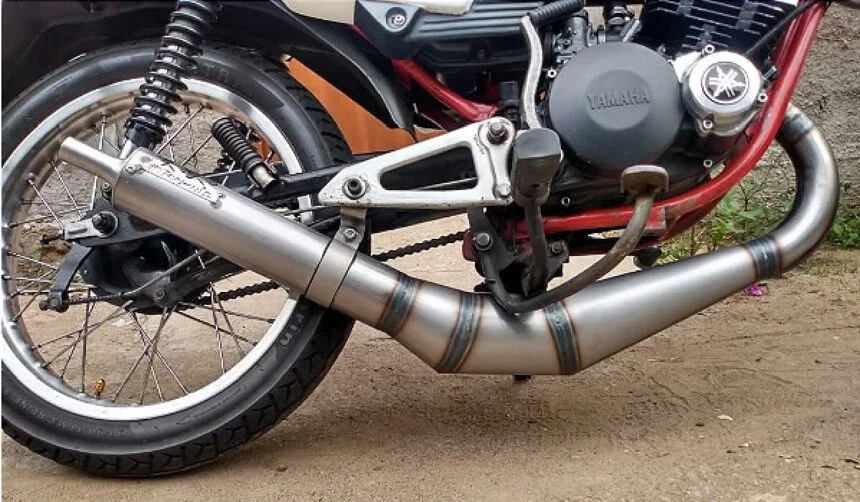Escapamento RD: The Heartbeat of Yamaha’s Legendary Two-Stroke Machines
The phrase “escapamento RD” may sound unfamiliar if you’re not into motorcycles, but for two-stroke enthusiasts, it sparks an immediate sense of nostalgia and adrenaline. Coming from Portuguese, the term translates to “RD exhaust”, and it refers specifically to the exhaust system of Yamaha’s legendary RD series. These bikes—ranging from the nimble RD125 to the powerful RD400—are iconic machines that became symbols of speed, rebellion, and pure riding pleasure in the 1970s and 1980s.
The escapamento, or exhaust system, is not just a mechanical component in these bikes; it’s the soul of the RD experience. From the sharp crackle of the pipes to the way they affect performance, the escapamento RD is at the center of what made these motorcycles unforgettable. To truly understand why RD bikes have a cult following decades later, we need to dive into the magic of their exhaust systems and the culture that surrounds them.
A Quick Look at the RD Series
Before talking about the escapamento RD, let’s set the stage. Yamaha’s RD series, short for “Race Developed”, was built on the foundation of lightweight, two-stroke performance machines. The series included models like the RD125, RD250, RD350, and RD400, each offering a unique blend of power and handling that left competitors scrambling to keep up.
Unlike heavy four-strokes of the same era, RDs were fast, light, and fun. They were the kind of bikes that a young rider could afford yet still use to challenge bigger machines on the road. With their screaming two-stroke engines and aggressive styling, the RDs quickly became more than just motorcycles—they became cultural icons. And at the heart of their character was the exhaust system, the escapamento RD.
The Role of the Escapamento RD
If you’ve ever heard a two-stroke engine fire up, you know the sound is unlike anything else in the motorcycle world. The exhaust plays a huge role in shaping that sound, but it’s not just about noise—it’s also about performance. The escapamento RD was carefully designed to work with the engine’s two-stroke cycle, creating that famous “powerband” that made the bikes so addictive to ride.
Unlike four-stroke engines, two-strokes rely heavily on exhaust tuning to manage the flow of gases and to optimize combustion. The RD exhaust pipes were crafted not only to expel burnt gases but also to send pressure waves back into the cylinder, helping to “stuff” more fuel-air mixture into the engine. This gave the bikes their explosive acceleration and made them feel alive in a way few other motorcycles could match.
The Famous Two-Stroke Sound
One of the most distinctive things about the escapamento RD is the sound it produces. When you start an RD, you’re greeted with a sharp, crackling exhaust note that quickly builds into a high-pitched wail as the revs climb. It’s the kind of sound that can make passersby turn their heads instantly.
For many riders, this sound is pure nostalgia. It represents freedom, youth, and the thrill of speed. Unlike modern four-stroke bikes with muted exhausts, the escapamento RD was raw and unapologetic. You didn’t just ride an RD—you announced it to the world.
Customization and Performance Upgrades
Over the years, many RD owners began experimenting with aftermarket exhausts to squeeze even more performance out of their bikes. Tuned expansion chambers became popular, allowing riders to increase horsepower and shift the powerband to suit their riding style.
In places like Brazil, where the term “escapamento RD” is commonly used, custom exhausts became a badge of honor. Riders would swap pipes not only for performance but also for the unique sound they produced. The right escapamento RD could turn an already thrilling bike into something truly wild.
Escapamento RD and the Powerband Experience
Ask any RD rider about what makes these bikes special, and they’ll likely mention the powerband. This is the surge of power that comes when the engine hits the sweet spot in its RPM range. The escapamento RD plays a huge role in shaping this experience.
When tuned correctly, the exhaust helps the engine breathe more efficiently, making the bike feel tame at low revs and then suddenly explosive as the RPMs climb. This on-off personality is part of what makes riding an RD so exciting. It requires skill, timing, and a sense of daring to ride these bikes to their full potential.
The Culture Around Escapamento RD
The escapamento RD is more than just metal tubing; it’s part of a culture. In the 1970s and 80s, these bikes became symbols of youth rebellion. Riders loved the rawness, the noise, and the sheer fun of wringing out a two-stroke engine. The exhaust pipes, loud and proud, became part of the rider’s identity.
In many countries, gatherings of RD enthusiasts would often turn into symphonies of exhaust notes, with riders revving their bikes just to hear that addictive two-stroke crackle. Even today, online communities of RD fans often swap stories and videos of escapamento RD setups, keeping the spirit alive.
Escapamento RD as a Visual Statement
Beyond performance and sound, the escapamento RD also has a visual appeal. The curving expansion chambers and distinctive pipes give the bikes a muscular, aggressive look. In many ways, the exhaust pipes became part of the RD’s personality. They weren’t tucked away or hidden—they were proudly displayed, showing the bike’s racing DNA.
For custom builders and restorers, the exhaust is often one of the first things they pay attention to. A polished set of pipes can transform an RD from a dusty relic into a head-turning classic. The escapamento RD, then, is not just functional—it’s also a form of art.
Comparing RD Exhausts to Modern Systems
Modern motorcycles are subject to strict noise and emissions regulations, which has dramatically changed the design of exhaust systems. Today’s pipes are quieter, bulkier, and often fitted with catalytic converters. While they are better for the environment, they lack the raw character of the escapamento RD.
This is part of the reason why RD bikes and their exhausts hold such appeal for enthusiasts. They represent a time before regulations, when motorcycles were built for pure excitement. Riding an RD today, with its screaming exhaust, feels like stepping back into a more rebellious era.
Preserving and Restoring Escapamento RD
As RD bikes age, maintaining their exhaust systems becomes increasingly important. Rust, dents, and wear can take their toll on original pipes. Many collectors go to great lengths to preserve or restore the escapamento RD to its original glory. Some even hunt for rare OEM parts, while others turn to skilled fabricators to reproduce classic designs.
Restoring an RD exhaust is not just about keeping the bike running—it’s about preserving history. Each pipe carries the legacy of a motorcycle that defined an era, and enthusiasts take pride in keeping that legacy alive.
Escapamento RD in Racing History
The RD series wasn’t just popular on the streets—it also made waves in racing. Many amateur racers used RDs as entry-level machines, and their exhaust systems were often the first things to be modified for track performance. Tuned escapamentos allowed riders to extract maximum horsepower and compete against larger, more expensive bikes.
This racing heritage only adds to the mystique of the escapamento RD. When you hear that crackling exhaust note, you’re hearing echoes of countless races, battles, and victories from decades past.
Why Escapamento RD Still Matters
In a world where motorcycles are becoming quieter, heavier, and more regulated, the escapamento RD remains a symbol of purity. It reminds us of a time when bikes were raw, fun, and unfiltered. The sound of an RD at full throttle is more than just noise—it’s history, culture, and passion rolled into one.
For younger riders discovering these machines, the escapamento RD is often their first introduction to the magic of two-strokes. For older enthusiasts, it’s a time machine that takes them back to their youth. Either way, the appeal is timeless.
The Future of Escapamento RD
As classic motorcycle culture continues to grow, the escapamento RD is likely to become even more celebrated. Restorations, custom builds, and even retro-inspired modern bikes ensure that the spirit of the RD lives on. The exhaust, with its unique sound and performance characteristics, will always be central to that spirit.
Even if regulations prevent bikes like the RD from being built again, enthusiasts will keep their escapamentos singing, ensuring that future generations get to experience what made these machines so special.
Final Thoughts on Escapamento RD
To talk about Yamaha’s RD series without mentioning the exhaust would be impossible. The escapamento RD is not just a mechanical necessity—it’s the heartbeat of these legendary bikes. From the way it shapes performance to the unforgettable sound it produces, the exhaust system is what gives the RD its soul.
Whether you see it as a performance upgrade, a cultural symbol, or a piece of motorcycle art, the escapamento RD continues to inspire riders around the world. It represents freedom, rebellion, and the pure joy of riding. And in that sense, it will always remain one of the most iconic elements in motorcycle history.





